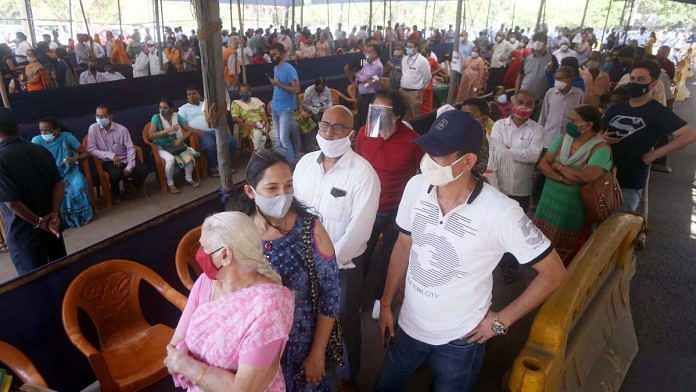New Delhi: Facing an unprecedented surge in Covid-19 cases, Maharashtra had requested the Centre to revisit the norms for Covid testing that decide whether a person is positive or negative. The Indian Council of Medical Research (ICMR), the country’s nodal body for medical research, has now written back saying the proposed revision in positivity criteria will cause too many infections to be missed and increase the transmission of the disease further.
According to the research body, the current positivity criteria is based on the cycle threshold (Ct), which is a measure of how soon after an RT-PCR test the SARS-CoV-2 is detected in a sample. As the samples move through cycles, the sooner the virus is detected, the higher the viral load is supposed to be.
“ICMR has taken inputs from different virology laboratories across the country to arrive at a single Ct value cut-off based on individual laboratory experiences. As per uniform consensus, a Ct value cut-off of 35 with a good sigmoidal real-time RTPCR curve is acceptable,” ICMR Director General and Secretary, Health Research, Dr Balram Bhargava wrote in a letter to Maharashtra Principal Secretary (Health) Dr Pradeep Vyas.
“All patients with a Ct value of =< 35 may be considered as positive while those with Ct value greater than 35 may be considered as negative. All samples with CT value =< 35 a poor sigmoidal curve should be essentially retested. Implementing a Ct value cut-off of 24 is not at all advisable as this would lead to missing of several infectious patients and increase disease transmission,” he added. ThePrint has a copy of the letter dated 5 April.
Bhargava wrote that the globally accepted cut-off for Ct value for Covid-19 ranges from 35-40 depending upon the instructions laid down by individual manufacturers.
However, Vyas said the Maharashtra government did not seek a change to the Ct value.
“We never requested GoI to reduce CT value, [we] requested [it] to clarify as it appeared [that] different labs and different states were adopting different practices. The state only wanted to know in view of different standards in different documents of ICMR,” he told ThePrint.
He also shared a document from the Institute of Genomics and Integrative Biology where a sample of adequate viral load was defined as a sample with a Ct value of less than 22.
Also read: Reasons behind Maharashtra’s disastrous Covid showing dragging the India story down
Lower Ct value may mean more severe disease
The World Health Organization maintains that the Ct needed to detect the virus is “inversely proportional to the patient’s viral load”. “Where test results do not correspond with the clinical presentation, a new specimen should be taken and retested using the same or different NAT technology … disease prevalence alters the predictive value of test results; as disease prevalence decreases, the risk of false positive increases.”
This means that the probability of a person who has a positive Covid result is truly infected with SARS-CoV-2 decreases as prevalence decreases, irrespective of the claimed specificity of the test.
NAT refers to tests that are based on the presence of certain nucleic acids. The RT-PCR test is considered the gold standard for detecting coronavirus.
Some studies suggest that lower Ct values may be associated with a worsening of symptoms, though many experts say such a linear correlation is difficult to establish.
“Data suggest that lower Ct values may be associated with worse outcomes and that Ct values may be useful in predicting the clinical course and prognosis of patients with COVID19,” British and US researchers wrote in a review published in the journal Infectious Diseases and Therapy.
(Edited by Manasa Mohan)
Also read: How Covid-19 is striking back with a second wave — lessons from the three worst-hit states



